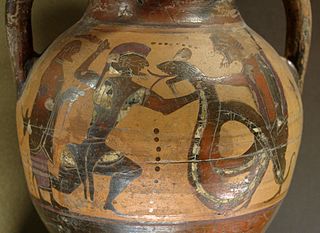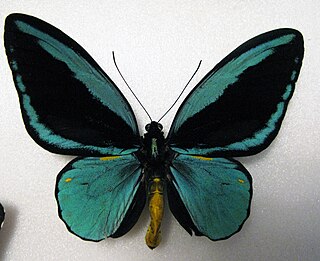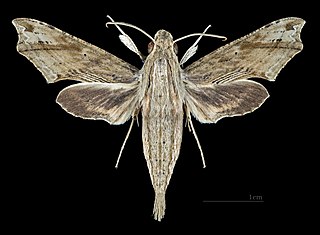| Eryphanis | |
|---|---|
 | |
| Eryphanis automedon , type species for the genus | |
| Scientific classification | |
| Kingdom: | |
| Phylum: | |
| Class: | |
| Order: | |
| Family: | |
| Genus: | Eryphanis |
Eryphanis is a genus of owl butterflies in the family Nymphalidae.
| Eryphanis | |
|---|---|
 | |
| Eryphanis automedon , type species for the genus | |
| Scientific classification | |
| Kingdom: | |
| Phylum: | |
| Class: | |
| Order: | |
| Family: | |
| Genus: | Eryphanis |
Eryphanis is a genus of owl butterflies in the family Nymphalidae.

In Greek mythology, Aesacus or Aisakos was a son of King Priam of Troy. Aesacus sorrowed for the death of his wife or would-be lover, a daughter of the river Cebren, and was transformed into a bird.

Balius and Xanthus were, according to Greek mythology, two immortal horses, the offspring of the harpy Podarge and the West wind, Zephyrus. In other traditions, Poseidon is the father of Xanthus along with another horse named Cyllarus to an unnamed mother. It is possible that Xanthus's ability to speak prophetically may be related to Arion, another mythical horse reported to have saved Adrastus from the battle of the Seven Against Thebes with his prophetic abilities in Statius's Thebaid.

In Greek mythology, Automedon, son of Diores, was Achilles' charioteer.
In Greek mythology, Diorês referred to three different people.

The German auxiliary cruiser Atlantis, known to the Kriegsmarine as Schiff 16 and to the Royal Navy as Raider-C, was a converted German Hilfskreuzer, or merchant or commerce raider of the Kriegsmarine, which, in World War II, travelled more than 161,000 km (100,000 mi) in 602 days, and sank or captured 22 ships with a combined tonnage of 144,384. Atlantis was commanded by Kapitän zur See Bernhard Rogge, who received the Oak Leaves to the Knight's Cross of the Iron Cross. She was sunk on 22 November 1941 by the British cruiser HMS Devonshire.
Edward L. G. "Ted" Bowell, is an American astronomer. Bowell was educated at Emanuel School London, University College, London, and the Université de Paris.

The South-East Asian Theatre of World War II was the name given to the campaigns of the Pacific War in Burma, Ceylon, India, Thailand, the Philippines, Indochina, Malaya and Singapore. Conflict in this theatre began when the Empire of Japan invaded French Indochina in September 1940 and rose to a new level following the raid on Pearl Harbor, and simultaneous attacks on Hong Kong, the Philippines, Thailand, Singapore and Malaya on 7 and 8 December 1941. The main landing at Singora on the east side of the Isthmus of Kra preceded the bombing of Pearl Harbor by several hours. Action in the theatre officially ended on 9 September 1945.

Obi is the main island in the Obi Islands group, in Indonesia, south of the larger Halmahera in North Maluku. Its area is 2,542 km².

Ornithoptera priamus, the common green birdwing, Cape York birdwing, Priam's birdwing or northern birdwing, is a widespread species of birdwing butterfly found in the central and south Moluccas, New Guinea, Bismarck Archipelago, Solomon Islands, and north-east Australia.
Automedon was an ancient Greek poet known from his poems in the Greek Anthology. Twelve epigrams of his are still extant and he is mentioned by Philippus of Thessalonica in the proem of his anthology Garland of Philippus. He is placed from the 1st century B.C to the 1st century A.D.

Ornithoptera aesacus, the Obi Island birdwing, is a rare species of birdwing butterfly, endemic to the Island of Obira, Indonesia.
2920 Automedon, provisional designation 1981 JR, is a large Jupiter trojan from the Greek camp, approximately 110 kilometers in diameter. It was discovered by American astronomer Edward Bowell at the Anderson Mesa station of the Lowell Observatory on 3 May 1981. The dark D-type asteroid has a rotation period of 10.22 hours and belongs to the 30 largest Jupiter trojans. It was named after the ancient Greek hero Automedon, the charioteer of Achilles.

Brassolini is a tribe usually placed in the brush-footed butterfly subfamily Morphinae, which is often included in the Satyrinae as a tribe Morphini. If this is accepted, the Brassolini become the sister tribe of the Morphini among the Satyrinae. Formerly, they were treated as an independent family Brassolidae or subfamily Brassolinae. Many members of this tribe are called owl butterflies.
SS Automedon was a passenger and cargo steamer which was shelled and sunk on 11 November 1940 during World War II by the German surface raider Atlantis. She was carrying Top Secret documents to the British Far East Command, the capture of which is thought by some to have played a prominent part in the Japanese decision to enter World War II.

Eupanacra is a genus of moths in the family Sphingidae.

Eupanacra automedon is a moth of the family Sphingidae.

Eupanacra malayana, the Malayan rippled hawkmoth, is a moth of the family Sphingidae.

Eupanacra regularis is a moth of the family Sphingidae.
In Greek mythology, the name Alcimus may refer to:

Eryphanis automedon, the Automedon giant owl, is a species of butterfly belonging to the family Nymphalidae.
| Wikimedia Commons has media related to Eryphanis . |
| Wikispecies has information related to Eryphanis |
| This Nymphalidae-related article is a stub. You can help Wikipedia by expanding it. |